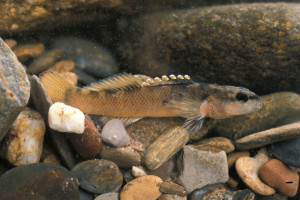By Chris Erwin
How long will the wait be before the 723 feet water level will return to Lake Cumberland? The answer seems like it could be pretty straightforward. Unfortunately, a little critter called a Duskytail Darter has put a kink in the U.S. Army Corp of Engineers’ plan to raise the water level back to its full depth. It has been seven years since the lake levels were lowered to repair the Wolf Creek Dam.
We received word this past year that the construction was completed and the water level would come up in stages and so it did. This summer the water levels came up to 705 feet just 18 feet below what it was before the construction began.
This past week, however, it was reported that the discovery of the Duskytail Darter in five miles of stream habitat in the headwaters region of the lake, which were exposed during the drawdown, confirmed the presence of the federally endangered fish. This discovery was the result of a stream survey, a required compliance commitment made by the Corps as part of the Record of Decision for the Wolf Creek Dam/Lake Cumberland Environmental Impact Statement as part of the emergency drawdown of the lake.

This week the Army Corp of Engineers and Kentucky Department of Fish and Wildlife released a public statement on the issue. “We are working closely with the Fish and Wildlife Service to determine an appropriate course of action, including what conservation measures could be implemented to minimize any potential impacts to this species,” said Lt. Col. John L. Hudson, U.S. Army Corps of Engineers Nashville District commander. “The lake will operate this coming recreation season at about 25 feet higher than when construction was ongoing at Wolf Creek Dam, which will enable the same access to the lake and its significant recreational opportunities as the public enjoyed last year. We are working in close consultation with the service to ensure our actions are protective of the endangered species and its habitat as required by the Endangered Species Act.”
A final decision about Lake Cumberland pool operating levels will be made after the Corps completes a biological assessment and the Fish and Wildlife service prepares a biological opinion. The outcome of that formal consultation process will determine the way forward.
“Our plan is to complete consultation with the Corps as soon as possible after we receive their biological assessment,” said Lee Andrews, field supervisor of the Fish and Wildlife Service’s Kentucky Field Office. “This is our top priority. We have already worked with the Corps to develop a number of potential conservation measures that, when implemented, will minimize impacts to the Duskytail Darter and expedite our review of the project. We will continue to work with our partners in the Corps to make that happen.”
So… what is the Duskytail Darter and what does it look like? I felt it was something our readers may what to know. As it turns out, the Cumberland River is the only place in Kentucky these little critter lives. The fish only grows to a length of about 2.5 inches, and its body color is brown with a series of dark-brown vertical bars on the sides. Breeding males have a dark head and a milky white anal fin. Fleshy golden knobs develop on the tips of the dorsal spines.
In Kentucky, this fish is only found in that section of the Big South Fork of the Cumberland River within the Big South Fork National Recreation Area. Duskytail darter populations are known to exist in only three other locations: Citico Creek, Tenn., Little River, Tenn., and Copper Creek, Va. Two other populations of this species are now believed to be extinct.
Its coloration serves to camouflage the fish. When disturbed they dart to cover. Duskytails feed on small crustaceans and aquatic insect larvae. Breeding takes place in late April and lasts through June. A male will establish his territory under a large flat rock. The female will turn upside down and deposit her eggs in a cluster on the underside of this large rock. The male then fertilizes and guards the eggs until they hatch.
To answer our original question, the lake appears to be on hold at 705 feet until it can be established that raising the lake to 723 feet will not adversely impact the life cycle of this small endangered fish. We will pass along any new information as it becomes available.



Be the first to comment